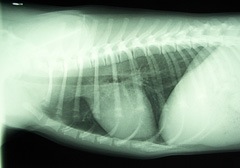The diaphragm is the muscular separation between the chest and abdominal cavities. The diaphragm keeps thoracic and abdominal organs separate as well as aiding respiration.
Ruptures in the diaphragm allow abdominal organs to migrate into the chest cavity, effectively ‘squashing’ the lungs and compromising their capacity to expand during breathing. This break in the diaphragm - called a diaphragmatic hernia – can be the result of trauma such as a car accident or, more rarely, the hernia can be congenital. Sometimes the trauma has happened days, weeks or even months before the intestine or other organs find the tear and enter the chest, causing sudden respiratory distress.
Diagnosis
CVH vets diagnose and treat diaphragmatic hernias quite commonly in dogs and cats. Pets with diaphragmatic hernias are almost always presented with laboured breathing. They often have a rapid, shallow breathing pattern and sometimes will adopt an abnormal breathing posture – what we call dog-sitting – because when they lie down, the organs may slide further into the chest making it even harder for them to breathe.
X-rays of the chest show the normally distinct line of the diaphragm has disappeared. Depending on which organs have moved into the chest, there may be an obvious mass (such as the liver) or it’s possible to see a gas-filled stomach and/or intestines. Contrast radiography with barium is sometimes used to confirm the intestines and/or stomach are sitting within the thoracic cavity.
Images below: the image on the left shows a normal (dog) chest with an unbroken diaphragmatic line, clear silhouette of the heart and air-filled lungs. The image to the right shows the dense mass of the liver and stomach sitting in the chest cavity in a dog before surgery at CVH.


Treatment
The only treatment for a diaphragmatic hernia is surgery. Before surgery, the cat must be treated for shock (if the trauma has just happened) and breathing and heart rate stabilised.
Surgery can be challenging and difficult, depending on the extent of the tear in the diaphragm, adhesions that may have formed if the hernia was longstanding, and the fact that any surgery involving opening the thorax requires skillful anaesthesia – once opened, the thorax is no longer a vacuum and the lungs immediately collapse. The vets and vet nurses managing the anaesthesia must ‘breathe’ for the animal the entire duration of surgery to ensure oxygen continues to flow into the lungs and enter the circulation.
Once the hernia is almost fully repaired and closed, the anaesthesia becomes even more delicate. The lungs must be expanded by a squeeze of the oxygen bag at the exact moment the last suture closes the chest cavity. The amount of oxygen delivered is critical – too much and the anaesthetist risks rupturing lung cells, too little and the lungs don’t expand to full capacity.
Follow up to surgery
The repair of a diaphragmatic hernia involves major surgery. Pets need at least several days of intensive monitoring and pain management, rest, and treatment for any other injuries sustained if there has been a traumatic incident. Once over the initial stages of recovery, the cat can go home on strict rest and monitoring.
The prognosis for cats with a traumatic diaphragmatic hernia varies depending on other injuries sustained at the time, and the degree of adhesions if the hernia is longstanding. Most pets that recover successfully from surgery will regain full health.